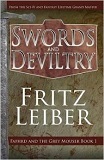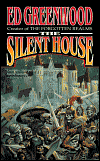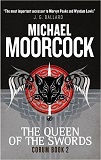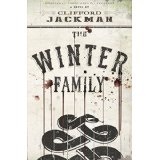
Swords and Deviltry, by Fritz Leiber
Book Review by Joshua Palmatier
Have you read this book?
I'm probably going to get roasted by the SF&F community for this, but... After hearing about this series for ages, I finally decided to check it out as part of my "reading new authors" quest this year. This series has been around for a while (since the 60s and 70s) so it's a little retro and I tried to take that into account as I read it. That didn't seem to help too much.
The premise: This first book is really simply three stories woven together to produce a book. The Snow Women is the back story of Fafhrd, relating his early life and how and why he flees and ends up in Lankhmar. Similarly, The Unholy Grail is the back story of the Gray Mouser and how he ends up in Lankhmar. And finally, Ill Met in Lankhmar is the story of how the two meet and become the famed Fafhrd and the Gray Mouser.
The third story is where the heart of this book lies, and also where I assume Fafhrd and the Gray Mouser caught readers' imaginations and really took hold. It is where I finally became interested in the two characters and where the story drew me in, with the two heading off to figure out how to hurt the thieves' guild and get revenge. Of course, things don't work out as planned and what started off as a mostly drunken excursion to scout things out becomes something much more meaningful to both of them. This is the real story, and this one story is the main reason that I'll go on and read the next book in the series.
Unfortunately, the two back stories for Fafhrd and the Gray Mouser didn't really catch my interest or hold my attention as well, especially Fafhrd's story (which was the introduction story in this book). I kept reading mostly because of what I'd heard from others about this series and this pair. The Gray Mouser's back story was more interesting and better written. Maybe the reason the second and especially the third story caught my attention and held it better is because they were more of what I was expecting in terms of "sword and sorcery," which is what these stories really are.
As I said, I tried to give the style of the writing some leeway, since they were written before I was born and the style then was slightly different. For example, the omniscient POV was much more prevalent, so what we now call "head-hopping" was more common. Now, we try mostly for third-person limited POV and "head-hopping" is frowned on (although still done occasionally). I must admit the head-hopping threw me and it took me a while to get used to it. The language itself and the structures of the sentences were also slightly "off" from current fiction, and that took some getting used to.
But in the end, I really think that my issues were with the story, not the style. The first one just didn't catch me. The second piqued my interested more, but it was the third where I finally felt that I was "getting" what everyone was raving out. The third story drew me in and, again, is why I'll go ahead and continue with the second volume.
Joshua Palmatier/Benjamin Tate
www.joshuapalmatier.com
www.benjamintate.com
The premise: This first book is really simply three stories woven together to produce a book. The Snow Women is the back story of Fafhrd, relating his early life and how and why he flees and ends up in Lankhmar. Similarly, The Unholy Grail is the back story of the Gray Mouser and how he ends up in Lankhmar. And finally, Ill Met in Lankhmar is the story of how the two meet and become the famed Fafhrd and the Gray Mouser.
The third story is where the heart of this book lies, and also where I assume Fafhrd and the Gray Mouser caught readers' imaginations and really took hold. It is where I finally became interested in the two characters and where the story drew me in, with the two heading off to figure out how to hurt the thieves' guild and get revenge. Of course, things don't work out as planned and what started off as a mostly drunken excursion to scout things out becomes something much more meaningful to both of them. This is the real story, and this one story is the main reason that I'll go on and read the next book in the series.
Unfortunately, the two back stories for Fafhrd and the Gray Mouser didn't really catch my interest or hold my attention as well, especially Fafhrd's story (which was the introduction story in this book). I kept reading mostly because of what I'd heard from others about this series and this pair. The Gray Mouser's back story was more interesting and better written. Maybe the reason the second and especially the third story caught my attention and held it better is because they were more of what I was expecting in terms of "sword and sorcery," which is what these stories really are.
As I said, I tried to give the style of the writing some leeway, since they were written before I was born and the style then was slightly different. For example, the omniscient POV was much more prevalent, so what we now call "head-hopping" was more common. Now, we try mostly for third-person limited POV and "head-hopping" is frowned on (although still done occasionally). I must admit the head-hopping threw me and it took me a while to get used to it. The language itself and the structures of the sentences were also slightly "off" from current fiction, and that took some getting used to.
But in the end, I really think that my issues were with the story, not the style. The first one just didn't catch me. The second piqued my interested more, but it was the third where I finally felt that I was "getting" what everyone was raving out. The third story drew me in and, again, is why I'll go ahead and continue with the second volume.
Joshua Palmatier/Benjamin Tate
www.joshuapalmatier.com
www.benjamintate.com
|
Click here to buy Swords and Deviltry, by Fritz Leiber on Amazon
|
Swords and Deviltry, by Fritz Leiber on Amazon

| More Books You Might Like |
Comment on Swords and Deviltry, by Fritz Leiber



